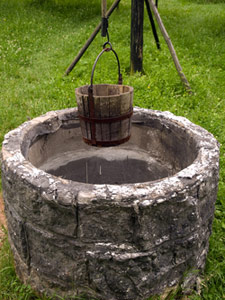Kansas well owners, non-well owners have different watering routines during droughts, study finds
Published on by Naizam (Nai) Jaffer, Municipal Operations Manager (Water, Wastewater, Stormwater, Roads, & Parks)
 During California's recent drought, media coverage focused on residents reducing water usage as a conservation measure.
During California's recent drought, media coverage focused on residents reducing water usage as a conservation measure.
However, a University of Kansas researcher who examines water conservation policy and the habits of well owners in Kansas said the story is likely more complex than that when individuals are organized by their types of water supplies.
Brock Ternes, a KU lecturer and doctoral graduate of sociology, has constructed one of the only datasets of wells owners used in the social sciences and found that well ownership is significantly correlated to increased watering during droughts and that water conservation varies among those who own different types of wells.
"People who have higher levels of awareness in Kansas tend to also be using more water during droughts, but I don't think that makes them bad environmentalists," Ternes said. "These are people who are more aware of their water supplies and in the business of using water."
Ternes surveyed 864 Kansans, of which 48 percent were private well owners and 52 percent relied on municipalities for their water supplies to their homes.
Like so many regions suffering from recent droughts, rural Kansas has been particularly hard-hit by the scarcity of water. The High Plains Aquifer — an underground water source that much of Kansas relies on for water — has been overpumped for its valuable irrigation water, and researchers estimate that unless pumping is curtailed, the aquifer will no longer support irrigation wells in portions of southwestern Kansas within 25 years, Ternes said.
It might seem counterintuitive that well owners — who are generally more aware of their own water supplies than those who rely on municipalities, according to Ternes' previous research — use more water during a drought, but he said it's likely a function of how they use the water, especially while irrigating crops. During non-drought years, adequate precipitation tends to reduce the reliance on groundwater for sustaining crops.
Ternes said well owners are likely more aware of water supplies and know when to tap into the aquifer to keep their crops alive because they can rely on adequate precipitation during non-drought years.
"When people are faced with a problem of resource scarcity, they don't necessarily curtail their consumption," Ternes said. "In other words, drawing from a stock of natural resources in times of scarcity or stress does not automatically disqualify someone from being an environmentalist. But over-users during times of abundance can be ruled out. This implies that groundwater stewardship requires selective timing for making extractions."
His latest research project adds to scholarship on well ownership and environmental citizenship.
"Groundwater is a crucial source of freshwater for people all over the world," Ternes said. "And wells moderate the relationship between water supply awareness and drought-time watering practices. This work suggests that environmental researchers need to study well owners as a distinct social group with consequential responses to droughts."
He will present his findings Tuesday, Aug. 15, at the American Sociological Association's 2017 annual meeting in Montreal.
Attached link
http://news.ku.edu/2017/07/28/kansas-well-owners-non-well-owners-have-different-watering-routines-during-droughts-studyTaxonomy
- Water Wells
- Water Conservation